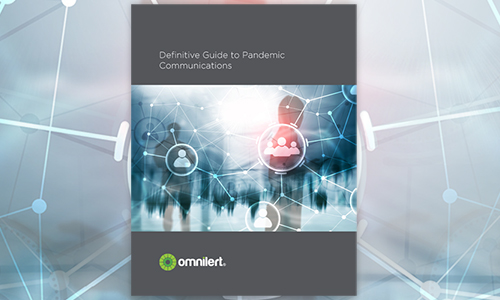The Definitive Guide to Pandemic Communications provides comprehensive step-by-step information to help you plan, execute, and improve upon your emergency response during difficult times, such as the COVID-19 global health crisis.
Pandemic Communications Best Practices
The government and the World Health Organization (WHO) are working to communicate the measures we should be taking to contain the coronavirus, but schools and organizations must also take these steps. Now is the time to proactively prepare for this rapidly spreading pandemic. Proper preparation will minimize the disruption of business operations to the greatest extent possible.
Perhaps, one of the most important steps your organization can take is to develop a Pandemic Communications Plan. Do you have a plan in place to communicate with employees and customers in such a situation? Have you automated the notifications to ensure they go to the right people at the right time?
To read more about Best Practices for Pandemic Communications, click here.
Pandemic Communications Templates
Regardless of planning, there is still an element of surprise when something unexpected happens. With that said, emergency preparedness can ensure quick and reliable execution when the time comes.
Communication is critical to keeping your people safe and minimizing the negative impact. Make sure critical messages are already in the queue. Draft pandemic communications templates as part of your planning process to initiate a quick response and limit errors.
To read more about Pandemic Communications Templates, click here.
Pandemic Communications for Higher Education
Colleges and universities play a key role in protecting the safety and security of students, faculty, staff, and their families. Conveying the right information at the right time can expedite response times.
The uncertainty of when the pandemic will end and the extent of its impact has made communication even more challenging. While the majority of higher education institutions have developed a pandemic communications plan, the coronavirus crisis is not over and improvements can be made in preparation for the future.
To read more about Pandemic Communications for Higher Education, click here.
Pandemic Communications and the Clery Act
The COVID-19 pandemic has created unique circumstances, especially for higher education institutions. There have been questions around how to ensure compliance with the Clery Act. The US Department of Education recently released updated guidance in accordance with this national emergency.
Adhering to the updated guidance will promote campus safety during this ongoing threat. Even though most colleges and universities have now made classes virtual, many essential employees and some students remain on campus.
To read more about the Updated Clery Act Guidance, click here.
You may download the full-length Definitive Guide to Pandemic Communications Guide here.








